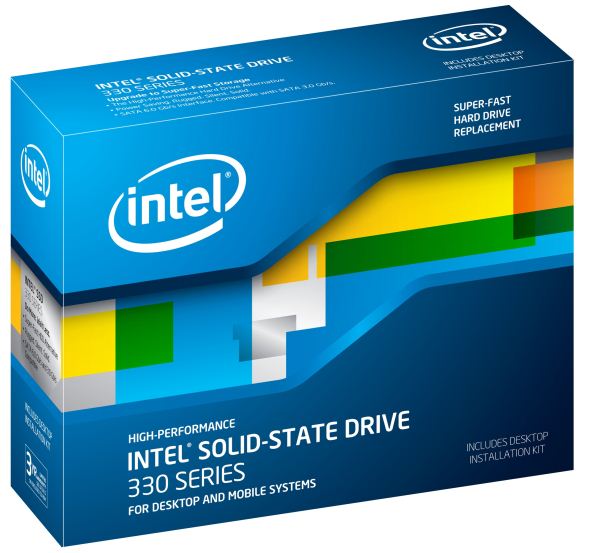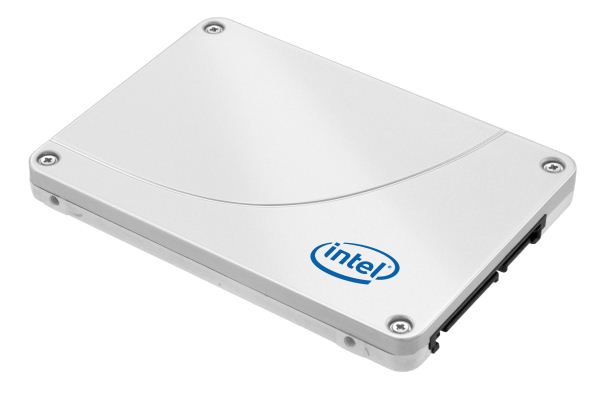Intel SSD 330 Officially Announced: Affordable SandForce
by Anand Lal Shimpi on April 16, 2012 11:00 AM ESTWe reported on Intel's SSD 330 weeks ago, but today is the official announcement of the drive and its availability in the channel. Unlike previous 300 series drives, the 330 isn't based on Intel's own controller - it's the second SandForce SF-2281 drive in Intel's lineup.
| Intel SSD Comparison | ||||||
| Intel SSD 520 | Intel SSD 510 | Intel SSD 330 | Intel SSD 320 | |||
| Capacity | 60 / 120 / 180 / 240 / 480GB | 120 / 250GB | 60 / 120 / 180GB | 40 / 80 / 120 / 160 / 300 / 600GB | ||
| Controller | SandForce SF-2281 | Marvell 9174 | SandForce SF-2281 | Intel X25-M G3 | ||
| Interface | 6Gbps SATA | 6Gbps SATA | 6Gbps SATA | 3Gbps SATA | ||
| Random Read Performance (Up to) | 50K IOPS | 20K IOPS | 42K IOPS | 39.5K IOPS | ||
| Random Write Performance (Up to) | 60K IOPS | 8K IOPS | 52K IOPS | 23K IOPS | ||
| Sequential Read Performance (Up to) | 550 MB/s | 500 MB/s | 500 MB/s | 270 MB/s | ||
| Sequential Write Performance (Up to) | 520 MB/s | 315 MB/s | 450 MB/s | 220 MB/s | ||
| Warranty | 5 years | 3 years | 3 years | 5 years | ||
The 330 differs from the SandForce based Intel SSD 520 in a couple of key areas. The 330 uses lower p/e count NAND (still Intel 25nm MLC) compared to the 520, reducing Intel's rated lifespan from 5 years of 20GB of writes per day to 3 years under the same workload. Intel's ratings have historically been conservative, so I'd expect that the 330 would last much longer than 3 years for the vast majority of workloads - particularly based on previous calculations on the topic. With a 3 year usable lifespan rating however, Intel dropped the limited warranty on the 330 to 3 years as well.
All of this results in a significant reduction in price compared to the 520:
| SSD Pricing Comparison | ||||||
| 60/64GB | 120GB/128GB | 180GB | ||||
| Crucial m4 | $79.99 | $154.99 | ||||
| Intel SSD 520 | $109.99 | $184.99 | $289.99 | |||
| Intel SSD 330 | $89 | $149 | $234 | |||
| Kingston HyperX 3K | $169.99 | |||||
| Samsung SSD 830 | $94.99 | $174.99 | ||||
| OCZ Vertex 3 | $98.99 | $159.99 | ||||
| OCZ Vertex 4 | $179.99 | |||||
In fact, the Intel SSD 330 appears to be the cheapest SF-2281 drive on the market today. Interestingly enough it's only available at three capacities (60, 120 & 180GB), while the Intel SSD 320 was available in far more models going all the way up to 600GB.
Performance ratings are down compared to the Intel SSD 520, although it's not clear whether these are artificial limits or not:
| Intel SSD 520 vs. 330 | ||||
| Intel SSD 520 120GB | Intel SSD 330 120GB | |||
| Capacity | 120GB | 120GB | ||
| Controller | SF-2281 | SF-2281 | ||
| Random Read Performance (Up to) | 25K IOPS | 22.5K IOPS | ||
| Random Write Performance (Up to) | 40K IOPS | 33K IOPS | ||
| Sequential Read Performance (Up to) | 550 MB/s | 500 MB/s | ||
| Sequential Write Performance (Up to) | 500 MB/s | 450 MB/s | ||
| Warranty | 5 years | 3 years | ||
| Price | $184 | $149 | ||
Presumably Intel's SSD 330 uses a similar custom firmware solution to the SSD 520, which should hopefully keep it safe from any SF-2281 related BSOD or other instability.
| Intel SSD 330 | |||||
| Capacity | 60GB | 120GB | 180GB | ||
| Controller | SandForce SF-2281 | SandForce SF-2281 | SandForce SF-2281 | ||
| Interface | 6Gbps SATA | 6Gbps SATA | 6Gbps SATA | ||
| Random Read Performance (Up to) | 12K IOPS | 22.5K IOPS | 42K IOPS | ||
| Random Write Performance (Up to) | 20.5K IOPS | 33K IOPS | 52K IOPS | ||
| Sequential Read Performance (Up to) | 500 MB/s | 500 MB/s | 500 MB/s | ||
| Sequential Write Performance (Up to) | 400 MB/s | 450 MB/s | 450 MB/s | ||
| Warranty | 3 years | 3 years | 3 years | ||
| MSRP | $89 | $149 | $234 | ||












75 Comments
View All Comments
Xeno_ - Monday, April 16, 2012 - link
Will this drive in 60GB perform better/worse than the 313 in 20GB for Intel's Smart Response Technology (SRT)?Its obviously MLC but has a larger capacity (the limit of SRT's capability I think), would this be a better choice than the 313 for that purpose? Also how does the 520 60GB Stack up against the above 2?
shanssv - Monday, April 16, 2012 - link
like to see 3 of this drives in RAID0 against Revodrive 3 X2 240GBTaft12 - Monday, April 16, 2012 - link
Anand,I've deployed many, many Intel 320 Series SSDs at my workplace with astounding results. Literally zero failures in over a year and a half on dozens of laptops and workstations.
I probably wouldn't consider this Sandforce-based offering, but are you aware of an EOL planned any time soon for the 320 series? It's been very, very good to us and I'd hate to see it go away.
bji - Monday, April 16, 2012 - link
What makes you think this drive will be any less reliable than the 320? Do you think that Intel is really going to release a drive that would wreck their SSD quality reputation? I don't think so ... which is why I bought a pair of 520s recently.nexox - Monday, April 16, 2012 - link
"""What makes you think this drive will be any less reliable than the 320?"""No power fail protection (I assume, since it's cheap, and the 520 doesn't have any) means less reliability. Consumer Sandforce controllers have never been impressive on power loss, and I imagine many of the BSOD events that people see can be traced back to data loss from bad shutdowns, though it's hard for me to say for sure, since I've never see one personally.
I'm a fan of the 320 simply because it's the cheapest drive with power fail protection, and the performance is certainly good enough for my needs. Then again, it's been a while since I felt the need to run the highest-spec hardware available. I tend to buy with value for money in mind, and since I value my data, the 320 currently leads the SSD pack for me.
bji - Monday, April 16, 2012 - link
Can you expand on why you think the sandforce drives have 'no power fail protection'?Are you saying that there are drives out there that 'lie' about the persisted state of data? If so, I'd really like to know about it.
Remember, that it's OK for a drive to cache data and not commit it to permanent store if either
a) the drive has a means for ensuring that the data is written even in the event of power loss, OR
b) the operating system did not ask for a guarantee that the data was persisted
Are you saying that the sandforce drives disobey (b), i.e. tell the operating system that they have written data that they haven't?
If so, I really want to know about it. That seems like it could be class-action-lawsuit worthy.
jwilliams4200 - Tuesday, April 17, 2012 - link
He mean's that it probably has no capacitors to provide a short reserve of power in the case of an unexpected power loss (such capacitors allow the SSD to write its index to flash before shutting down).All SSDs need to maintain an index which maps LBAs (sector addresses known to the host) to flash pages known only to the SSD. Many (most?) SSDs keep at least part of that index in volatile memory for at least some time before they write it to flash. If the index were updated in flash on every event (write or GC), performance would suffer, so most SSDs do not update the flash copy of the index immediately.
If the SSD loses power before it has updated the index, then you could lose some or all of your data. Unless the SSD has capacitors to provide a short power reserve to write the index to flash before shutting down in the event of an unexpected power loss.
bji - Tuesday, April 17, 2012 - link
I just did a little reading into the ATA command set, it looks to me like they have provisions for 'sync'ing the drive to ensure that data is persisted. For example, I'm seeing something called "Flush bit" that can be used in write commands to ensure that all data is written to persisted store (and thus impervious to power outage) before completion.Are you saying that SSD controllers ignore such bits, lying to the operating system and returning before the data (and all metadata such as LBA maps required to access the data) is written to flash?
If so, then this is a major issue - class action lawsuit worthy if you ask me.
If what you're saying is that when the operating system does NOT set the 'flush bit', then the data could be lost on power outage - well that's a complete non-issue. Unless you request a guarantee that the data is written using the flush bit, you don't get any guarantee. No capacitor needed.
jwilliams4200 - Tuesday, April 17, 2012 - link
I think you are confusing host data (which can be held in a write cache, or forced to flush to persistent storage, as you say) with SSD metadata (the index of LBAs to flash pages).I don't think there is any ATA command to force metadata to be written to persistent storage.
bji - Tuesday, April 17, 2012 - link
That doesn't matter. Flushing the user data to the drive without flushing the metadata to locate it has the same effect as not flushing the user data at all, with regards to the purpose of the flush bit, which is to ensure that the data is persisted.I consider data that is persisted as data that can be read back after a power outage. if the data can't be read back because its metadata wasn't flushed, then it is not persisted.
If I were implementing a controller, I would flush the LBA index along with the user data if the flush bit were set.
Hard drives use the rotational inertia of the spinning platters to ensure that data is flushed on power outage, and some SSDs use capacitors. If a controller doesn't have some way to guarantee that enough energy will be available to flush cached written data, then it had *better* properly honor the flush bit, which includes flushing the LBA index and whatever other metadata is necessary to read the data that was written with the flush bit.
I find it very hard to believe that SSDs are not doing this.